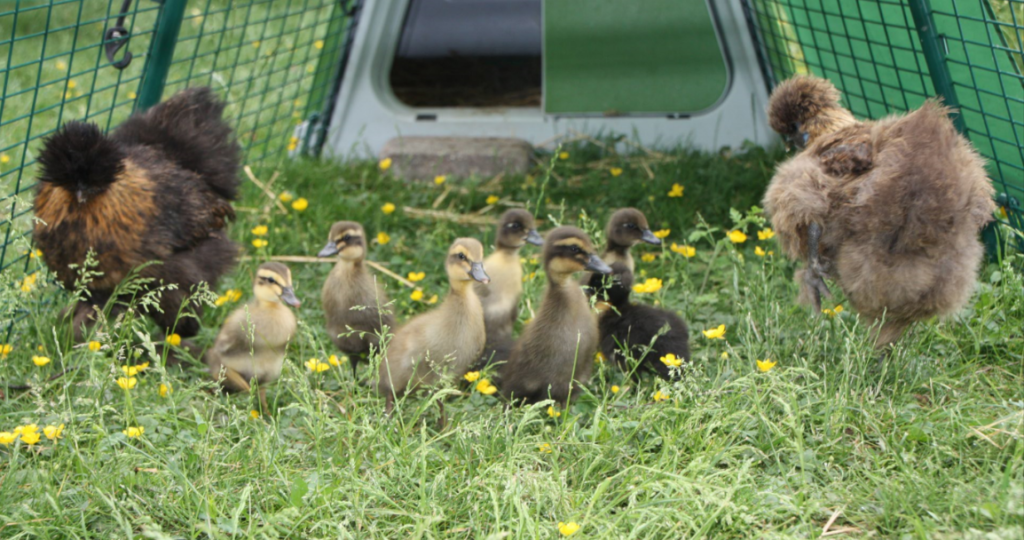
By Lotte Denckert
I’ve been lucky enough to be allowed to test the Omlet Eglu Go. Over the spring and summer I’ve first had a brood of chicks and later a brood of ducklings living in my Eglu Go.
The house is awesome to use as a broody coop and for raising chicks. The house is easy to clean, has good draught-free ventilation, it has a good size for chicks and ducklings, and the attached run gives great protection for the little ones early on, when they are very exposed in relation to birds of prey and other unwelcome guests.

Eglu Go for raising chicks
At first, my chicks were living in a cage in our guest room. They were hatched using an incubator and needed a chick brooder in the first few months as it was very cold outside. When the temperatures started to rise and the chicks had more well developed feathers, I moved them out into the coop. I kept them here for about 10 weeks. There were 10 chicks and they fitted easily in the coop until they were large enough to move into the large chicken coop with the grown-ups. I removed the roosting bars in the coop since small chicks don’t sleep on roosting bars in the beginning. I filled the coop with a generous layer of wood shavings and straw since it was still cold in the spring.
The coop is pretty easy to move around, especially if you add the wheels. You can therefore move the coop and run when the grass starts to get dull, this way, the chicks always have fresh grass to walk around on.
It’s great to have a closed run for the first while. Small chicks are exposed to birds of prey – this run keeps the birds from attacking. My grown hens were also a danger to the chicks in the beginning. Chickens aren’t always hospitable when it comes to new members of the flock. The small chicks could be left in peace in their run and the big hens could slowly get used to their presence. This made it so much easier to introduce them later, since they were already used to each other.

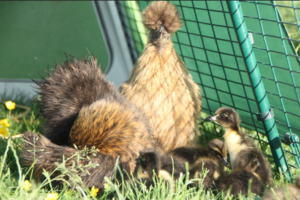
Hatching and rearing in the Eglu Go
When the chicks were too large to all live in the coop, I introduced them to the large flock, and then I suddenly had an empty Eglu Go. My ducks had laid a lot of eggs in a large nest but none of them were interesting in brooding. I already had two broody silkies, so I tried putting the duck eggs under them. The chickens weren’t discriminative about the eggs, and they happily lay brooding.. About a week before the eggs were supposed to start hatching, I moved the two hens and their eggs into the empty Eglu Go. The hens were very good about it and continued their persistent brooding, a week later 8 large ducklings came into the world.
Again, I had removed the roosting bars from the coop since ducks don’t sleep on roosting bars. This way, there was also room for two nests. The hens got along fine and they didn’t seem to mind that their babies had webbed feet rather than chicken feet.
Again, the other poultry in the garden could slowly get used to the new arrivals, and for that reason, there were also no issues when, a few weeks later, I let the ducklings and their mothers out to join the others in the garden.
The benefit of having ducks in an Eglu Go is that ducks often prefer to sleep outside. At night I let them into the run attached to the Eglu Go and close the run door so they are protected from predators. At the same time, they can decide for themselves whether to sleep in the coop or out in the run. In the morning I open the run door, so they can run freely in the garden and collect slugs, snails and insects.
I can definitely recommend this coop both for chicks and ducklings, whether hatched naturally or in an incubator. It’s a good idea to choose the 3 meter run, since it gives the little ones more space to play and explore.
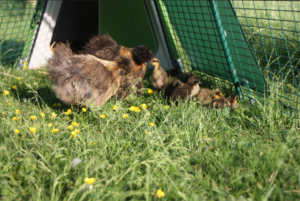
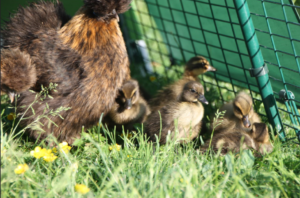
This entry was posted in Chickens on September 25th, 2018 by helenkennedy
Do or Don’t??
Are you considering buying a run for your cat?
5 degrees outside, oh how we’d love to open a window or the French Doors, but we have two indoor cats that might attempt to get out.
This is how we first got the idea for a cat run.
My husband is very determined that the house and garden should look good, so fencing in the whole garden was not an option for us. Anyway, fencing might keep our cats in, but it wouldn’t keep other cats out.
Next idea, should we build a run ourselves? No, it won’t look good next to the house and it’s not flexible.
I was looking around for something movable and flexible, but it just didn’t exist! Or did it? Suddenly I came across Omlets solution – exactly what I was looking for.
An outdoor run for which I would be able to decide the length and width myself. Easy to move, pack up, make smaller or make larger – and it’s green like the garden. One of the things I fell for is that you can place the run directly on the grass, so the cats have a natural floor to play on. The roof is made up of the same netting as the rest of the run, so the cats can keep an eye on what is happening in the sky, whether there’s a bird, a plane or something else.

When it rains the run can be covered so you can use it with your cats like a kind of covered terrace. The same covers can also be used to create shelter from the wind, shade from the sun or a guard to give the cats some peace and quiet.
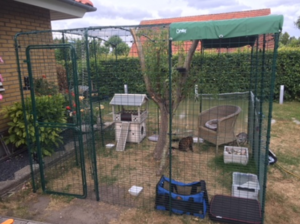
Some people might feel it’s not right to put cats in a cage, but I don’t see it as a cage at all. I call it the cats’ outdoor space. We keep them there to protect them but at the same time it gives them the opportunity to experience nature and get some fresh air without the risk of getting run over or get into other bad situations. Both our cats love their outdoor space and they use the entire run like one big climbing frame.
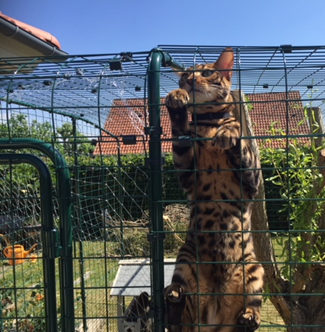
Now we can enjoy life outside with our cats
No more being woken up in the middle of the night or early in the morning – now we have two happy cats that get all the mental and physical stimulation they need in their outdoor space.
The Omlet Outdoor Cat Run has given us our outdoor life back and given our cats a better, healthier life.
– Maria, Roskilde
This entry was posted in Cats on September 17th, 2018 by helenkennedy
Last month, we celebrated International Cat Day by inviting all our lovely Omlet followers and customers from around the world to share their wonderful cat rescue stories on social media. Here is a selection of our favourite tales…

””I took my little kitty ’Bettemis’ and her sister into my care from Tøstrup shelter and animal welfare center, she was so small that we didn’t think she would survive, but she did. And when she was 2 years old she fell from a window and broke her pelvis in two places, this she survived as well. She is the most cuddly and affectionate cat I know, although she stamps when she walks. I have 4 cats and a dog.” – Lilian Fischer Krarup, from Denmark.

“This is my darling boy Yumyum. He was rescued from a very hectic household. Kids chasing and pulling his tail. So he was shut in a room with a filthy litter tray. He was two pounds in weight and eight weeks old. He was a feisty wee soul to begin with, but has settled in fine. He is now 14 yrs and has been diabetic for many years now. He has Insulin twice a day and special low carb biscuits. He has me wrapped around his little paw” – Helen, from the UK.

““This is Misfit, he came from our vet, she found him on the street, he was ill and no owner ever showed up, so we got him. We have 33 cats in total, many from Trøstrup shelter” –
Tilla Löewenhausen, from Denmark.
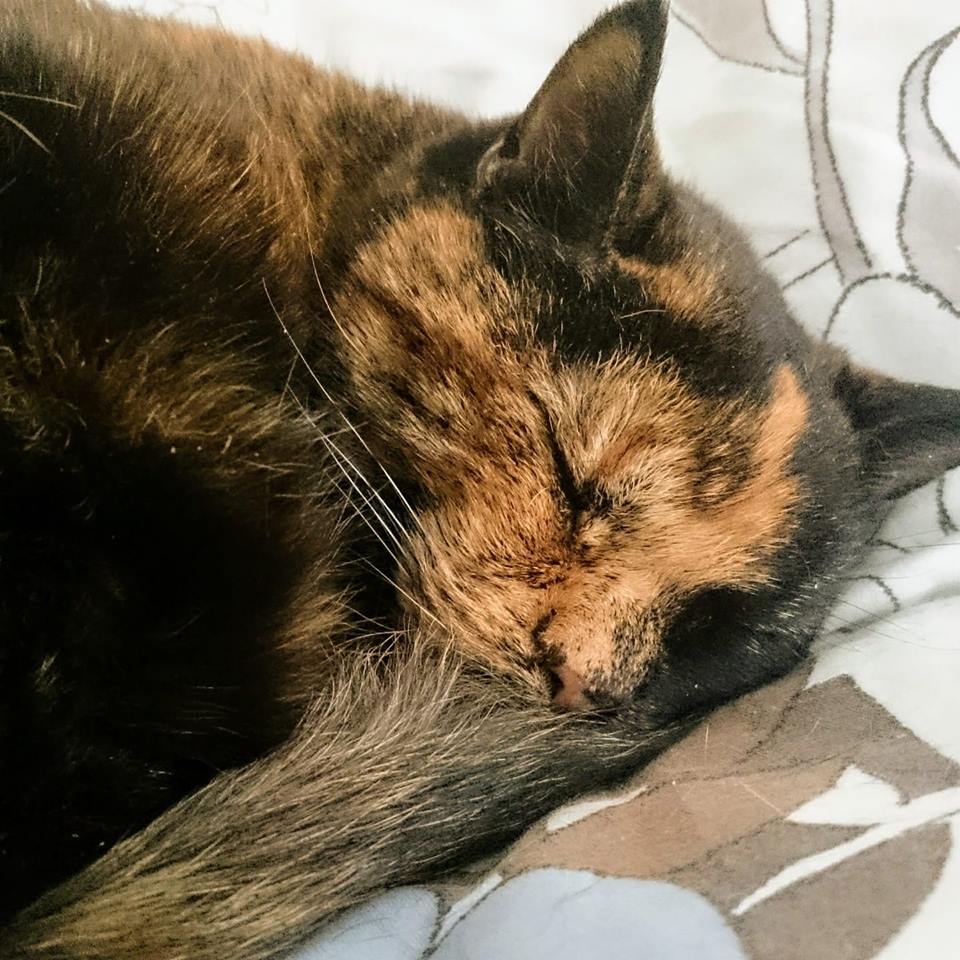
““This is Fröken Fräs. She waited for 10 years for a new home at the rescue centre in Lidköping. She was somewhat aggressive, not very outgoing, and no one’s first choice. It didn’t get easier when she got older and started getting dental issues. Now she lives in Dalarna and is a beloved family member of ours since a few years back. She loves prawns, to sleep in the sun, play with balls or just lay close to us and cuddle. There are a lot of cats like her out there – those older cats with a few flaws that, almost, no one wants.” – Pia, from Sweden.

“This is Jessie! She was rescued by Little Valley Animal Shelter and painstakingly nursed back to health after being found with her back leg completely skinned ? They thought they were going to have to amputate but their amazing care meant they didn’t have to in the end. It was a very long road to recovery but she is now fit, healthy and a beloved member of our family” – Charley, from the UK.
 ““This handsome cat is iPoes! I adopted her in 2010 from ‘t Julialaantje in Rijswijk (the Netherlands). Although she’s my cat, I can honestly say she is one of the sweetest cats I’ve ever met. She will never scratch or bite. Except the neighbor’s tomcat, she will make sure he leaves our house immediately!
““This handsome cat is iPoes! I adopted her in 2010 from ‘t Julialaantje in Rijswijk (the Netherlands). Although she’s my cat, I can honestly say she is one of the sweetest cats I’ve ever met. She will never scratch or bite. Except the neighbor’s tomcat, she will make sure he leaves our house immediately!
According to the animal shelter, iPoes used to live in a house with many other cats and dogs. In the beginning she wasn’t very social, and it took almost 2 years before she felt comfortable enough to sit on my lap. But this is not a problem anymore: now she likes to sleep next to me under the duvet with her head on my pillow! Although she’s very sweet, she’s not very clever… She is a very small cat and according to the vet her head is just too small for a big brain. But even after 8 years she still learns new things every day!” –Pauline, from Holland.
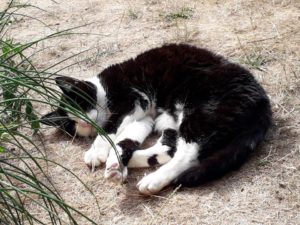
“Heddi is 17 years old and I rescued her back in 2001. She’s got a large personality and knows what she wants, and she always lets us know when she wants something, food or being let out into the garden – even at 5 in the morning! Nowadays she prefers to sleep outside and never leaves the garden. She hisses and chases male cats that come into the garden. Her kidneys are starting to act up, and she’s got arthritis, but she’s very happy and has perfect teeth. She’s got a friend who is two years younger, Nancy, with a completely different personality, but I love them both.” –
Jag älskar båda lika mycket.” – Annika, from Sweden.
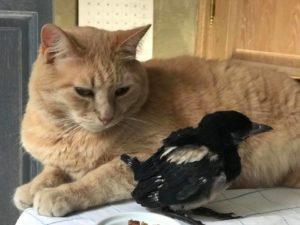 ““Bibi, has been rescued 9 years ago! We found him straying in our neighborhood a very cold and snowy day of winter, we presume his owners decided they didn’t want him anymore. He came to my door, I let him entered and he never left. He is so thankful that he accept all the new rescues animal in our house, even this bird that doesn’t want to leave haha” – Joëlle, from France.
““Bibi, has been rescued 9 years ago! We found him straying in our neighborhood a very cold and snowy day of winter, we presume his owners decided they didn’t want him anymore. He came to my door, I let him entered and he never left. He is so thankful that he accept all the new rescues animal in our house, even this bird that doesn’t want to leave haha” – Joëlle, from France.
 ““Hi, let me introduce you to Obi & Ficelle! We have recently adopted Obi, he is a 3 months old kitten that we found in the street where he was starved and sick! Today, he lives the perfect life with his soul sister Ficelle which we have got from a rescue center located in north of France.” – Cassandre, from France.
““Hi, let me introduce you to Obi & Ficelle! We have recently adopted Obi, he is a 3 months old kitten that we found in the street where he was starved and sick! Today, he lives the perfect life with his soul sister Ficelle which we have got from a rescue center located in north of France.” – Cassandre, from France.
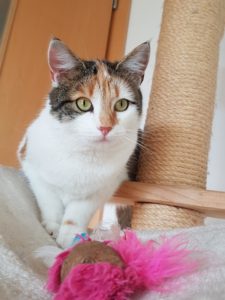 ““We picked up our cat Mia from the rescue centre in Murtal / German in September 2017. Our other rescue pets were excited about her arrival as well.” – Marlena, from Germany.
““We picked up our cat Mia from the rescue centre in Murtal / German in September 2017. Our other rescue pets were excited about her arrival as well.” – Marlena, from Germany.
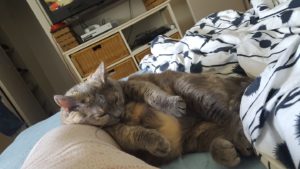 ““Luna is from Lund shelter. We don’t know her story. We just know that she was there for a very long time. She wasn’t very talkative when we got her. Today she sleeps in my arm under the duvet and can act on command.” – Charlotte L Hansen, from Denmark.
““Luna is from Lund shelter. We don’t know her story. We just know that she was there for a very long time. She wasn’t very talkative when we got her. Today she sleeps in my arm under the duvet and can act on command.” – Charlotte L Hansen, from Denmark.
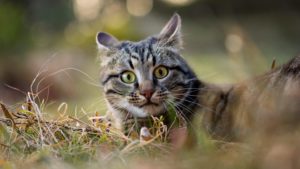 ““In the summer of 2006 a kitten suddenly showed up outside our house. He was extremely thin, had a large cut on his stomach and ridden with ear mites. It took me two days to catch him, but then only a few minutes before he calmed down and started purring. I already have 4 neutered male cats, and the plan was never to keep him, but we quickly had to give up that idea. He stole my heart! We named him Alvin and he is now as big a part of the family as the other cats.” – Jennifer, from Sweden.
““In the summer of 2006 a kitten suddenly showed up outside our house. He was extremely thin, had a large cut on his stomach and ridden with ear mites. It took me two days to catch him, but then only a few minutes before he calmed down and started purring. I already have 4 neutered male cats, and the plan was never to keep him, but we quickly had to give up that idea. He stole my heart! We named him Alvin and he is now as big a part of the family as the other cats.” – Jennifer, from Sweden.
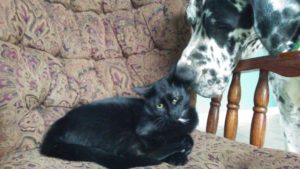
““Sir George is my foster failure from 2 years ago with Diamonds in the Ruff Animal Rescue in Lockport NY. George came to me at 4 days old and right from the start was a medical learning process. He developed a hernia from straining with chronic diarrhea by 5 weeks old. He continued to struggle and failed to thrive until he was 9 months old. We did a lot of tests, and a lot of food trials. My vet is awesome and she wouldn’t give up – and neither would Diamonds. We finally found a diet that George could tolerate. He is allergic to dairy, fish and carbs. He has swung from diarrhea to constipation to just right. July 4th this year, he urinary blocked. My vet again is awesome and saved me a trip to the ER. He is on chronic medications as well as a special diet (which at one time included home cooked meals). Due to the malnurishment at an early age, he is my “mini” kitty but is happy, and doing great!” –Cathryne, from USA.
You can read more amazing stories on our Facebook page!
This entry was posted in Cats on September 17th, 2018 by helenkennedy
In August the Danish Bulldog Club hosted a bulldog show in Denmark, where Omlet sponsored prizes for the ‘Most Beautiful Head’ category! We had a chat with the organisers to learn a bit more about the bulldog and find out why they focus so much on promoting the healthy bulldog.



Why is there a focus on promoting health in bulldogs at this show?
We focus on promoting bulldog health at all our shows and the reason why we have so much focus precisely on health is that many bulldogs (many different varieties) unfortunately have become more and more at risk of illness.
We believe it’s important to show the healthy dog that can breathe, move freely, is not bothered by allergies etc.
What are the signs of a healthy bulldog? And what are the most common health problems in bulldogs?
A healthy bulldog can move around freely. Meaning it is not physically limited. Open nostrils that do not create breathing problems, and it’s important that they are not overweight since this can put pressure on their hips etc.
The most common health problems are skin problems, hip/elbow dysplasia, breathing problems/narrow nostrils.





For those interested in getting a bulldog, what can they do to ensure they buy a healthy one? And how can you help your bulldog stay healthy if you already have one?
When buying a bulldog, the best way you can make sure it’s healthy is by seeing documentation for the parents such as x-rays of the hips, elbows, back etc. If possible, it is best to met both parents, but at least you need to see the mother.
Likewise, it’s important that you familiarise yourself with the breed and for instance go to a show where you can see and meet different dogs and breeders.
When you have your bulldog, the best thing you can do is to keep it slender/muscular and in good shape. Make sure it gets the right amount of exercise, food and lots of love. Remember that the bulldog is not just a sofadog. A bulldog needs exercise and stimulation just like other breeds.
What is the best thing about bulldogs compared to other dog breeds?
The bulldog is a very versatile breed which is suitable for everything from family dog to a hardworking training buddy.
The dogs enormous personality makes it a fun and loving member of the family and its muscular body og strong determination makes it the ultimate training partner for everything from obedience to weightpull.
Generally, the bulldog easily adapts to the individual family’s needs.



How many different varieties of bulldog are there and do you host shows for all of them in DBC?
There are: English Bulldog, French Bulldog, Old English Bulldog, Leavitt Bulldog, Renascence Bulldog, Continental Bulldog, American Bulldog etc.
However, in Denmark the American Bulldog is illegal.
So far, we only host shows for the OEB and Leavitt Bulldogs.
What might people not know about bulldogs?
They are super charming and very stubborn but they bring out smiles and laughs every single day.
***Winners of the ‘Most Beautiful Head’ category – sponsored by Omlet***



This entry was posted in Dogs on September 17th, 2018 by helenkennedy
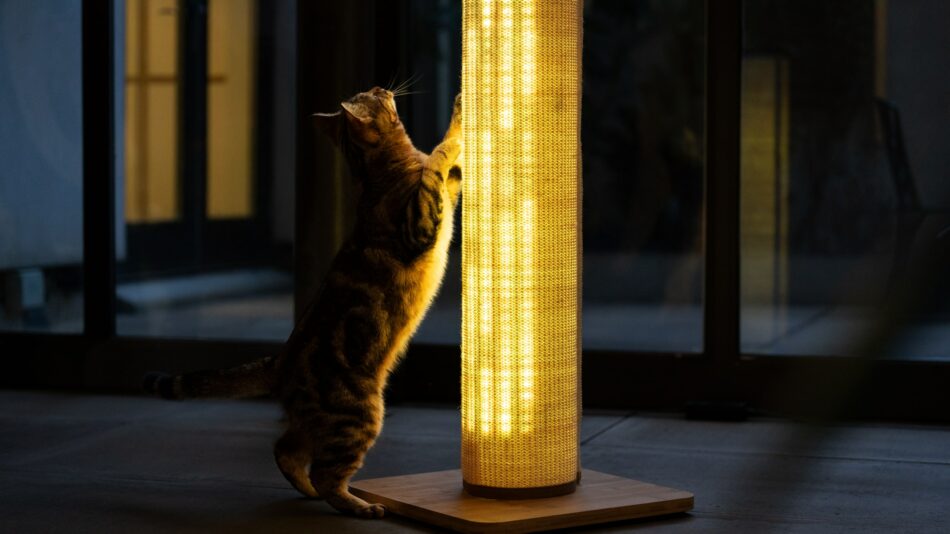
Did you know that it’s becoming increasingly common for our pets to be overweight? Obesity in cats not only poses a risk to physical health such as a greater risk of developing serious problems like cardiac diseases, cancer, diabetes and arthritis, but can have an impact on their wellbeing too. Fortunately, helping your cat lose weight is simple and even fun, meaning your feline friend can soon be on their way to living a healthier and longer life.
Breed or obesity?
It’s not always straightforward to tell if your cat is overweight, especially if they have long hair and are a generally stockier breed. But, a healthy cat should have a well-proportioned body with a defined waist and neck. You should be able to easily feel your cat’s ribs and hip bone, and they should have minimal abdominal fat. Speak to your vet about what the ideal weight is for your cat’s breed but generally speaking, if your cat is between 10%-19% over this, then they’re considered overweight. 20% and over their optimum weight and your cat is considered obese.
5 tips to help your cat lose weight
Making the decision to help your overweight cat lose weight is the first step in giving them the life they deserve. But, before taking any measures and changing your cat’s diet, consult your veterinarian. They’ll be able to guide you on how much to feed your cat and identify if there are any other medical conditions that could be contributing to their weight.
1. Control the calories
Look for canned, high-quality, meat-based, and highly digestible food to give your cat. Canned or raw food contains a large percentage of water, which can help a cat feel full on fewer calories, and also allows you to control how much food you give your cat every day. Canned wet food is also better than dry food, as it means your cat won’t be nibbling on food throughout the day and eating when they’re not hungry.
Measure out how much food you’re going to give your cat in a day, and make sure you stick to it. Dividing the food into smaller and more frequent meals can help if you feel your cat is struggling with hunger, but keep track of what and how much you are giving them. If you live in a multi-cat household, feed your dieting pet separately to stop them from stealing food.
2. Less treats, more affection
High-calorie treats have to go and make sure everyone in the family knows the rules! It might seem unfair to completely stop giving your cat treats, but it’s the nicest thing you can do for them at this stage to help them lose weight.
Try substituting treats with a cuddle or a cat toy. You’ll find most cats will respond just as well to the extra attention. If you still feel like you want to treat your cat with something edible, look for low-calorie treats or try some vegetable cat nibbles such as broccoli, green beans or pumpkin.
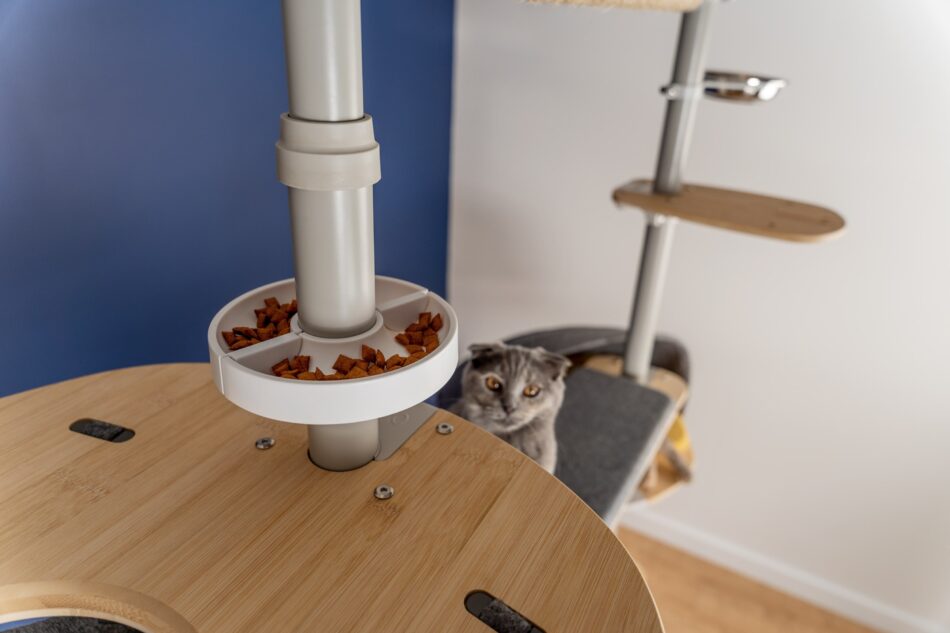
3. Take your time
Weight loss should be done slowly and steadily to reduce the risk of several health issues, like fatty liver disease. Your cat should not lose more than 3-4% of their total body weight per month, so it’s important to be patient on their weight loss journey.
If you’re changing your cat’s diet, make sure you do this gradually to avoid upsetting their stomach. Substitute more and more of the old food with your new, healthier choice every day, or reduce the amount of food little by little.
4. Make time for play
Introducing new cat toys and games into your feline’s life can not only decrease boredom, help cats bond with their owners, and improve agility and coordination, but will also help them to lose weight by burning calories.
Try to find out what types of toys your cat likes, and switch them around every now and then to make sure they don’t get bored. Different cats like different toys, but feathers and catnip-infused toys will be a hit with most! Encourage games that force your cat to move around and use their entire body, such as searching for hidden things or chasing toys.
A scratcher is another great choice of cat toy, especially one that lights up. The Switch Cat Scratcher offers all the benefits of cat scratching such as supporting their hunting instincts and getting your pet active, but takes feline fitness to another level.
With your cat’s very own light show, the Switch provides pets with their own interactive entertainment system. Join in on the fun in the evenings for pet parent playtime or turn the Switch on whilst you’re at the gym to give your cat a workout of their own.
With over 1200 settings to control the light, speed, brightness and mode of the scratcher, you can find the best way to connect in colour with your feline friend.
5. Leashes aren’t just for dogs
Some cats love walking on the lead, others, not so much. If you’ve never tried before, allow your cat to get used to their harness at home first. You can then start with a short walk in the backyard or around the block. If their body language tells you they’re relaxed and content, you can increase the distance gradually.
Don’t worry if it proves a real challenge – some cats will never accept walking on a leash, and you should never force them. Stick to other forms of exercise such as playing with toys or a Freestyle Cat Tree from Omlet, which will allow them to get moving and unleash their inner wild side, whilst remaining safe in the home.
Omlet and your cat
Omlet designs products to meet the needs of cats of all sizes and breeds. Our ingenious cat products make for better bonding between pet and owner, meaning every feline can be on their way to living the best life possible. From our light-up Switch Cat Scratcher to our fun Freestyle Cat Tree, our designs continue to evolve the more we keep asking about what our pets and their owners want.
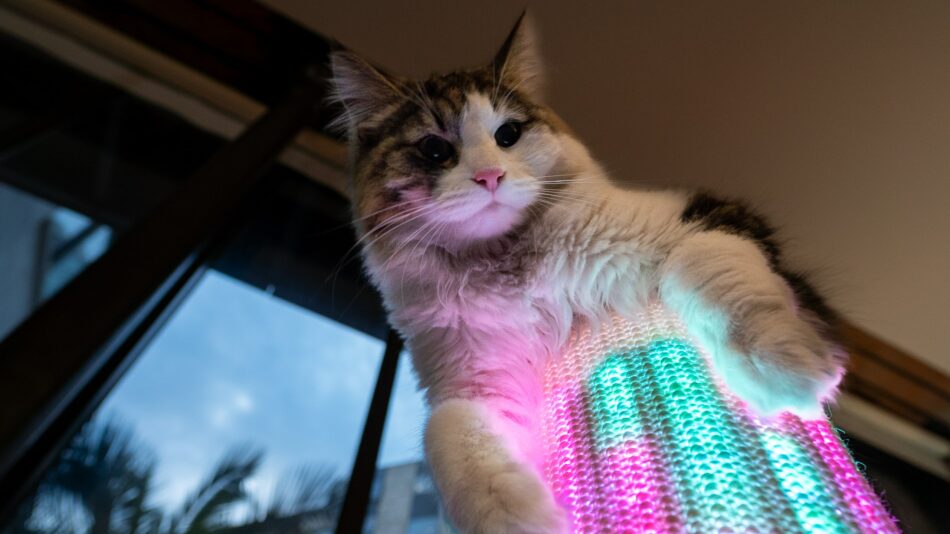
This entry was posted in Cats on September 10th, 2018 by helenkennedy
Raspberry & Lemon Meringue Roulade
We’ve always been fans of a super spring pavlova for dessert, but this year have been rolling up all that yumminess into a meringue roulade that guarantees a taste of all the flavours in every spoonfull!
Ingredients for meringue:
6 Eggs (whites only)
300g Caster Sugar
25g Caster Sugar for sprinkling
1 tsp Cornflour
1 tsp White Wine Vinegar
Ingredients for filling:
400ml Double Cream, whipped
Small jar Lemon Curd (homemade if possible)
2 punnets of Fresh Raspberries
Icing sugar for dusting

Method:
1) Preheat the oven to 180c, line a baking sheet with non-stick baking parchment.
2) Whisk the egg whites until they form firm peaks.
3) Sprinkle the cornflour and white wine vinegar over the whisked egg whites then add the sugar steadily whilst still whisking.
4) Spread the meringue mixture onto the lined baking tray.
5) Bake for 10 mins at 180c then turn the oven down to 160c and bake for another 10 mins until the meringue is starting to colour and is firm to touch.
6) Lay a clean tea towel on the work surface, place a sheet of parchment over the top and sprinkle with 25g caster sugar.
7) Take the baked meringue out of the oven and turn upside down on the prepared sugar dusted parchment, remove the baking sheet, allow to cool completely.
8) Once the meringue is cool, peel off the sheet of baking parchment that it was baked on and spread the whipped cream over the whole area of of the meringue.
9) Dollop/spread spoonfuls of lemon curd at regular intervals over the cream and scatter the raspberries on top.
10) Using the parchment paper for support, carefully roll the meringue to resemble a swiss roll, ensuring the parchment and tea towel don’t get caught up in the dessert!.
11) Transfer to a serving platter, dust with icing sugar and enjoy!












Recipe courtesy of Hen Corner

www.hencorner.com
This entry was posted in Recipes on September 10th, 2018 by helenkennedy




















































